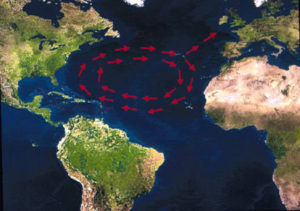
A magnetic map and smart swimming help endangered loggerhead turtles survive during migration.
Immediately after emerging from underground nests on eastern Florida’s beaches, loggerhead sea turtles scramble into the sea and embark alone on a migration around the entire North Atlantic basin. Survivors of this epic journey eventually return to North America’s coastal waters.
The most comprehensive perspective to date on how young loggerheads navigate the transoceanic migration was recently published in two complementary papers produced by a research team led by Professor Kenneth J. Lohmann, a marine biologist at UNC-Chapel Hill.
Watch an NSF video about Lohmann’s research on turtles programmed from birth to migrate.
The team’s most recent paper argues that young loggerheads, which begin migrations as two-inch-long hatchlings, likely advance along their open-sea route through a combination of strategic swimming interspersed with passive drifting on favorable ocean currents. They swim only in places where they are in danger of being carried off course and drift passively in other areas where ocean currents move in the direction that the turtles want to go. The two behaviors enable young loggerheads to migrate long distances on limited energy stores.

“Young turtles probably rely on a strategy of ‘smart swimming’ to optimize their energy use during migrations,” Lohmann said. “The new results tell us that a surprisingly small amount of directional swimming in just the right places has a profound effect on the migratory paths that turtles follow and on whether they reach habitats favorable for survival.”
The research, published in the June 2012 issue of The Journal of Experimental Biology, was partially funded by the National Science Foundation (NSF).
The findings, which were based on computer simulations combining ocean currents and ‘virtual turtles’ swimming for various periods of time, challenge a belief that young sea turtles drift passively and that their distribution is determined entirely by ocean currents. “Most researchers have assumed that, because ocean currents in some places move faster than young turtles can swim, the turtles cannot control their migratory paths,” Lohmann explained. “This study shows otherwise.”
“The research team’s results have important implications for ‘weakly moving animals,’ including larval fish, butterflies and ballooning spiderlings,” said David Stephens, a program director at NSF. They suggest that even small amounts of effort from these creatures can have big effects on where they end up, and how they get there.
Stephens continued: “All those things that we’ve thought of as ‘just drift along with the current’ might, after all, have a lot of control over where they’re going, with minimal effort!”
This discovery may be particularly useful in understanding commercially important creatures, such as fish and crab, that have weakly swimming larvae that, like turtles, have often been assumed to drift passively, added Lohmann. An improved understanding of their movements may lead to better fisheries management.
A related paper published by Lohmann’s team explains how young Florida-hatched loggerheads know where they are and in what direction to steer as they migrate around the North Atlantic basin. The paper, which appears in the April 2012 issue of Current Opinion in Neurobiology and describes research funded by NSF, reports that the turtles are guided at least partly by an inherited “magnetic map.”
The Earth’s magnetic field differs slightly in different geographic areas. The turtles’ magnetic map enables them to instinctively and wondrously use differences in the fields as navigational markers that serve as equivalents to road signs for turtles in the open sea. Each change in the magnetic field elicits a change in the turtle’s swimming direction, which in turn steers the turtle along its migratory route.




